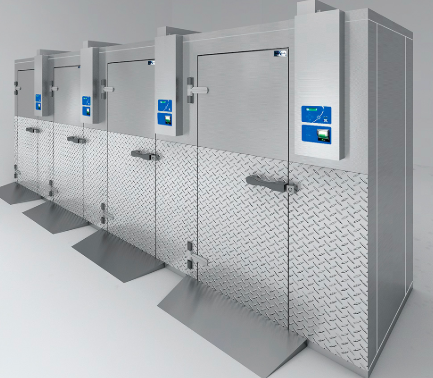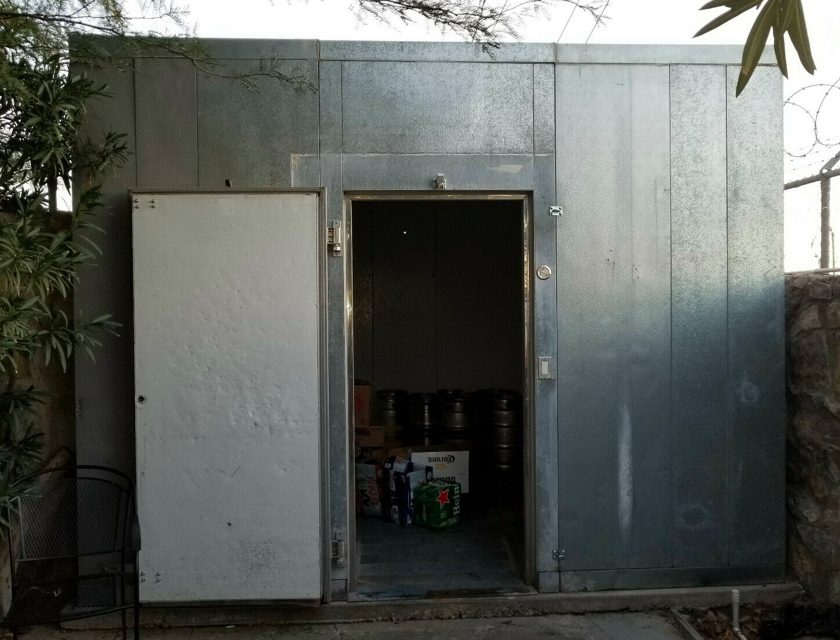A good walk-in cooler can change the entire workflow of a hard-working commercial kitchen, increasing efficiency and organization, helping to control inventory and reduce waste, and keep everything from stock pots of soup to fresh produce chilled safely. They’re also a super handy location for front-of-house staff to hide and cry after getting yelled at by an overzealous line cook. If you’re ready to make the leap into this type of walk-in refrigeration, there are a few things you should know, before making this potentially expensive purchase.
To view our used commercial walk-in cooler inventory, browse the live listings below. Each cooler is for sale by the owner of the unit. We don’t take any fees or commissions meaning that you get the best price when you shop with us. Click here to view our other categories of preowned restaurant equipment.
[display_listings l_type=”88″]
Often, walk-in coolers are built into the structure of the restaurant’s kitchen itself, and can be seamlessly integrated into existing walls. But so-called “drop-in” walk-in coolers are also an option for anyone looking to retrofit an existing building for commercial cooking applications. Walk-in coolers come in a variety of shapes and sizes, from tiny units not much larger than a few commercial refrigerators placed end-to-end, to gigantic models that can reach 20×20 feet or greater. Choosing the appropriately sized walk-in cooler that’s right for your business depends on the quantity of sales you are doing and how often you are turning over your inventory, the amount of additional power consumption that’s right for your budget, and the physical space you have set aside for housing such a large piece of equipment.
How Do you Use a Used Walk-in Cooler?

Every restaurant kitchen is set up a little differently, but here’s a fairly typical configuration. Smaller, reach-in fridges and freezers are typically scattered across the space or near specific cooking stations, which hold things like finished elements of dishes, like cooked chicken or pork, backup containers of finished sauces or side dishes, or “work-in-progress” items that are either being saved for another service, or waiting to be finished later (think marinating meats, prepped and chopped vegetables, or anything that’s next in line to be used, including back-up containers of prepped food waiting to be swapped into the sandwich or prep units).
In the back of the kitchen, or even in another room entirely, such as the dry storage area or in the basement, sits the walk-in cooler. This is where you’ll typically find cases of fresh produce, uncooked cases of meat or fish, or bulk orders of things that typically get run through quickly, such as butter, milk, or heavy cream. The walk-in cooler may also contain bulk sizes of condiments, sauces, or prepped or “cook and serve” items such as pie or biscuit dough.
How to Evaluate a Used Walk-in Cooler

Purchasing a used walk-in cooler can be intimidating; after all, not only is this an enormous and heavy piece of equipment, with an enormous and heavy price tag to match, but it’s also one of the pieces of equipment most likely to cause financial catastrophe if it breaks down. Walking in to a warm walk-in cooler is one of the worst feelings in the world, and will cause your entire staff to break into a scramble to find alternate storage for potentially thousands of dollars of unsold inventory.
When evaluating a used walk in-cooler for potential purchase, the first thing to do is walk around it carefully banging on the walls. No, seriously. Listen for hollow sounds and note whether the walls have any “give,” which could indicate either low-quality, collapsed, or waterlogged insulation, which will dramatically affect the efficiency of your walk-in cooler.
Check all of the seams where the panels fit together, and be on the lookout for suspicious globs of caulking, or anything else that indicates an attempt at “do-it-yourself” repair by a dishwasher, who was likely instructed simply to “go fix the walk-in, or you’re fired.”
Next, take a long, hard look at the entry door. It should sit squarely in its frame, and be easy to open and close. Check the seal around the door; it should be tight against the body of the unit, with plenty of flexibility and pliability (hard or cracked seals indicated very old vinyl, which is inefficient and will need to be replaced).
Check the metal itself. This is a great way to gauge the original price of the unit; lower-end walk-in coolers will be made of smooth metal (except in the case of stainless steel), and textured or pebbled surfaces will stand up better to able and imperfections. Because these surfaces are more expensive to produce, they usually mean a higher-grade cooler.
If you notice rust or corrosion, you’re probably looking at cheap galvanized metal, which may lead to problems down the road. A whitish residue means the cooler is likely made of aluminum, which is lightweight but more prone to damage from the inevitable kicks and punches you will inevitably give the cooler when it suddenly stops working.
Check For Buildup of Grease and Grime in Air Vents
Check for buildup of grease, dust or grime in the air vents, and listen closely to the sound of the compressor; any clanging or unusual sounds (these will be hard to miss; it’ll sound like someone trying to feed a wheelbarrow full of tin cans through a wood chipper) could indicate an issue with the fan or fan housing, which could spell trouble in the future.
Check for ice buildup or suspicious puddles inside the unit, which may indicate a problem with the unit’s thermostat, compressor, or defrost cycles. And of course, most importantly, check to make sure the unit is maintaining temperatures of at least 40 degrees or colder.
Try to figure out how the cooler is built. Lower-end or older walk-in coolers will be constructed around a wood frame. There are two schools of thought on this. Some owners like wood-framed walk-ins because they are structurally bulletproof; every time a delivery person runs a hand truck into the side of the cooler, or an entire side of beef collapses and falls inside the unit, wood-framed coolers can stand up to the abuse.
However, wood framing is also prone to absorbing odor and moisture, can promote mold growth, and has little to no insulating strength. Most modern coolers are constructed using smaller internal fasteners, which will have telltale plugged 1-inch holes scattered around the various panels; look for these, to get an indication of how your potential cooler is constructed.

Determine what type of insulation is used in the walk-in cooler. Polyurethane insulation is best; it provides the best balance of insulation strength and sturdiness. Watch out for coolers that use extruded polystyrene in their construction; it’s basically the same as the cheap foam board you’d find at any home improvement store, and doesn’t provide the same insulation value as polyurethane.
Be wary of used walk-in coolers with prices which seem too good to be true; we’ve seen plenty of used walk-ins for sale that are cosmetically perfect and with a low sticker price, with only a quick mention at the end of the description that the compressor doesn’t work. While this may seem like an inexpensive way to purchase an otherwise very costly piece of equipment, be aware that purchasing a new compressor for your refrigerator can cost hundreds (or even thousands) of dollars.
Finally, check for code and safety issues. Is there a light inside the walk-in cooler, with an indicator bulb near the door that lights when the inside light is on? Is there an internal release for the door, in case anyone gets trapped inside? And are there NSF stickers present, indicating that the cooler is approved for food use?
How to Integrate a Used Walk-in Cooler into Your Kitchen
When it comes to integrating a used walk-in cooler into your existing kitchen, your biggest determining factor is probably going to be size. Quite simply: Where can you fit the damned thing? Well, that’s where it’s going. If you’re designing or building a kitchen from scratch, however, consider how placement of the walk-in cooler will impact the workflow of your staff.
The walk-in cooler needs to be somewhat out of the way, while still easily accessible to kitchen staff, who may make multiple trips per day into the walk-in for ingredients and to put prepped food away.
